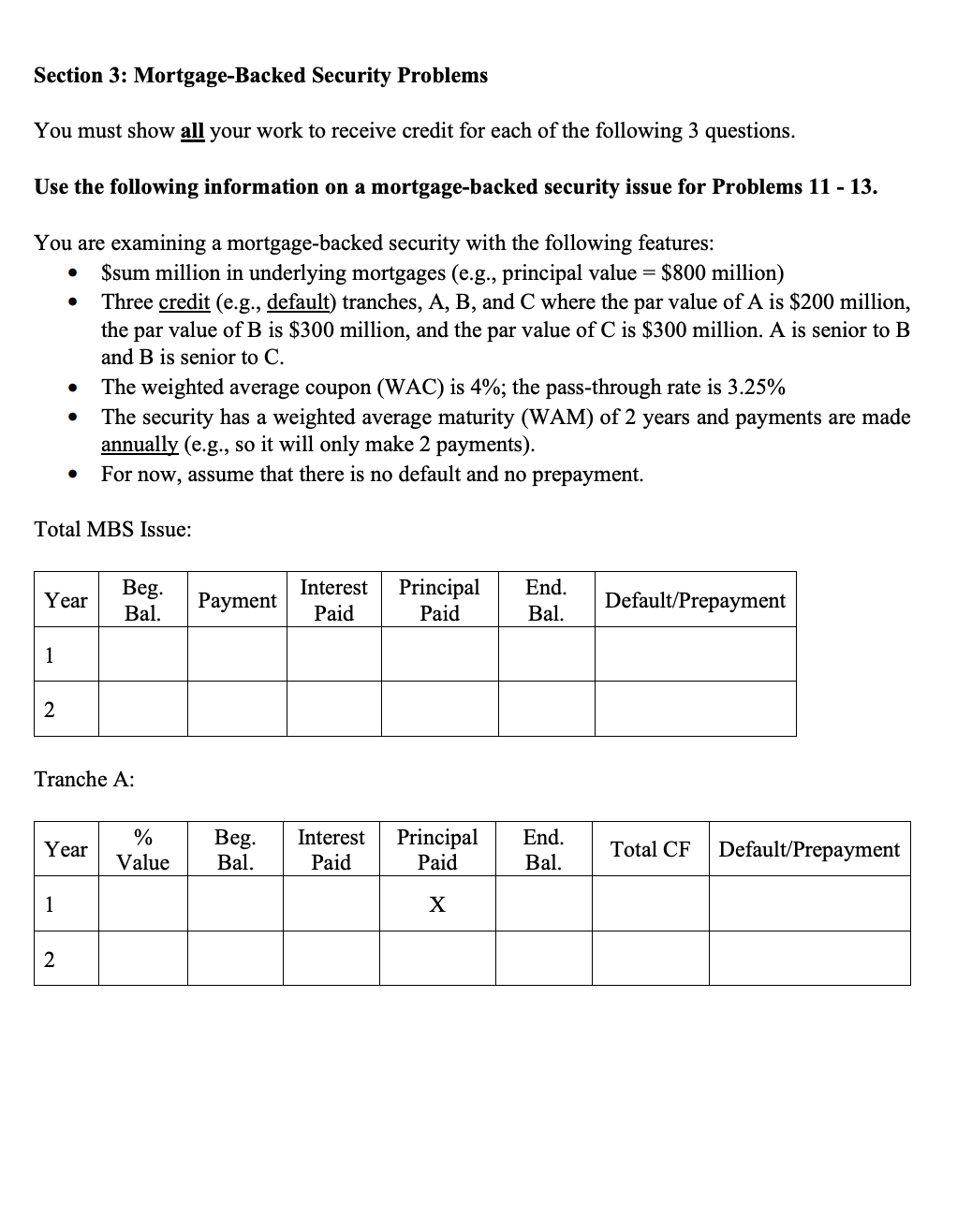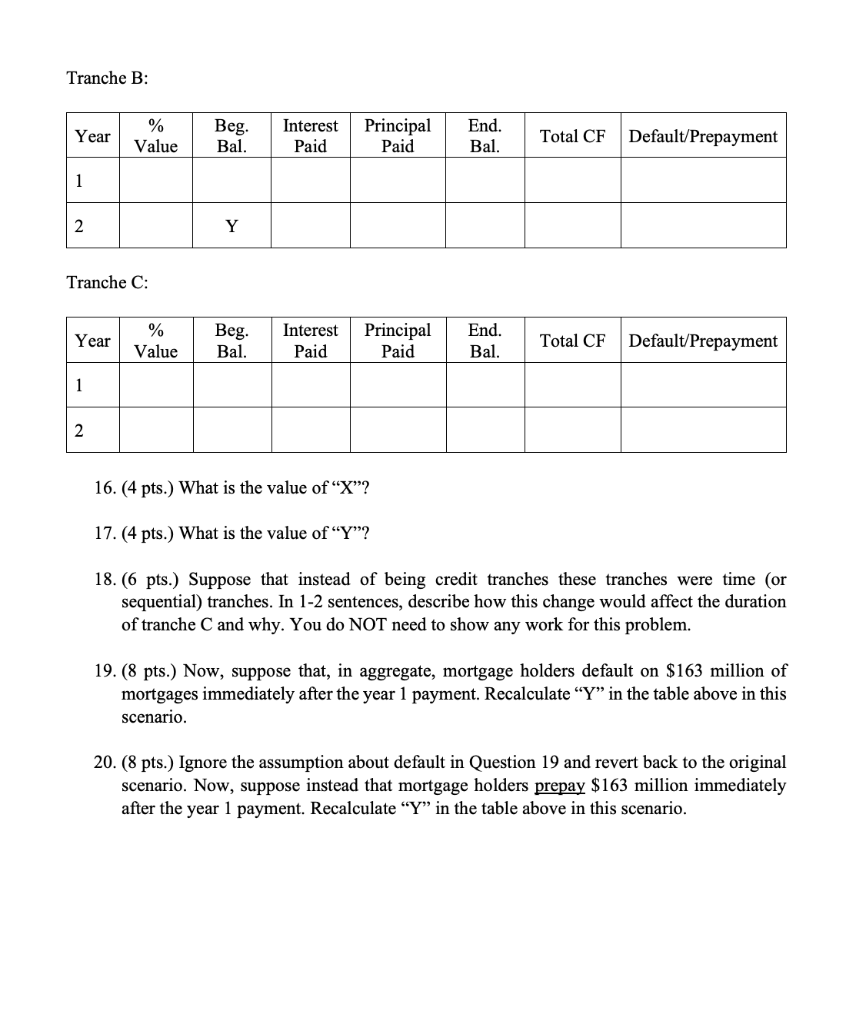

Section 3: Mortgage-Backed Security Problems You must show all your work to receive credit for each of the following 3 questions. Use the following information on a mortgage-backed security issue for Problems 11 - 13. . . You are examining a mortgage-backed security with the following features: $sum million in underlying mortgages (e.g., principal value = $800 million) Three credit (e.g., default) tranches, A, B, and C where the par value of A is $200 million, the par value of B is $300 million, and the par value of C is $300 million. A is senior to B and B is senior to C. The weighted average coupon (WAC) is 4%; the pass-through rate is 3.25% The security has a weighted average maturity (WAM) of 2 years and payments are made annually (e.g., so it will only make 2 payments). For now, assume that there is no default and no prepayment. . Total MBS Issue: Year Beg. Bal. Payment Interest Paid Principal Paid End. Bal. Default/Prepayment 1 2 Tranche A: Year % Value Beg. Bal. Interest Paid Principal Paid End. Bal. Total CF Default/Prepayment 1 X 2 Tranche B: Year % Value Beg. Bal. Interest Paid Principal Paid End. Bal. Total CF Default/Prepayment 1 2 Y Tranche C: Year % Value Beg. Bal. Interest Paid Principal Paid End. Bal. Total CF Default/Prepayment 1 2 16. (4 pts.) What is the value of X? 17. (4 pts.) What is the value of Y? 18. (6 pts.) Suppose that instead of being credit tranches these tranches were time (or sequential) tranches. In 1-2 sentences, describe how this change would affect the duration of tranche C and why. You do NOT need to show any work for this problem. 19. (8 pts.) Now, suppose that, in aggregate, mortgage holders default on $163 million of mortgages immediately after the year 1 payment. Recalculate Y in the table above in this scenario. 20. (8 pts.) Ignore the assumption about default in Question 19 and revert back to the original scenario. Now, suppose instead that mortgage holders prepay $163 million immediately after the year 1 payment. Recalculate "Y" in the table above in this scenario. Section 3: Mortgage-Backed Security Problems You must show all your work to receive credit for each of the following 3 questions. Use the following information on a mortgage-backed security issue for Problems 11 - 13. . . You are examining a mortgage-backed security with the following features: $sum million in underlying mortgages (e.g., principal value = $800 million) Three credit (e.g., default) tranches, A, B, and C where the par value of A is $200 million, the par value of B is $300 million, and the par value of C is $300 million. A is senior to B and B is senior to C. The weighted average coupon (WAC) is 4%; the pass-through rate is 3.25% The security has a weighted average maturity (WAM) of 2 years and payments are made annually (e.g., so it will only make 2 payments). For now, assume that there is no default and no prepayment. . Total MBS Issue: Year Beg. Bal. Payment Interest Paid Principal Paid End. Bal. Default/Prepayment 1 2 Tranche A: Year % Value Beg. Bal. Interest Paid Principal Paid End. Bal. Total CF Default/Prepayment 1 X 2 Tranche B: Year % Value Beg. Bal. Interest Paid Principal Paid End. Bal. Total CF Default/Prepayment 1 2 Y Tranche C: Year % Value Beg. Bal. Interest Paid Principal Paid End. Bal. Total CF Default/Prepayment 1 2 16. (4 pts.) What is the value of X? 17. (4 pts.) What is the value of Y? 18. (6 pts.) Suppose that instead of being credit tranches these tranches were time (or sequential) tranches. In 1-2 sentences, describe how this change would affect the duration of tranche C and why. You do NOT need to show any work for this problem. 19. (8 pts.) Now, suppose that, in aggregate, mortgage holders default on $163 million of mortgages immediately after the year 1 payment. Recalculate Y in the table above in this scenario. 20. (8 pts.) Ignore the assumption about default in Question 19 and revert back to the original scenario. Now, suppose instead that mortgage holders prepay $163 million immediately after the year 1 payment. Recalculate "Y" in the table above in this scenario








